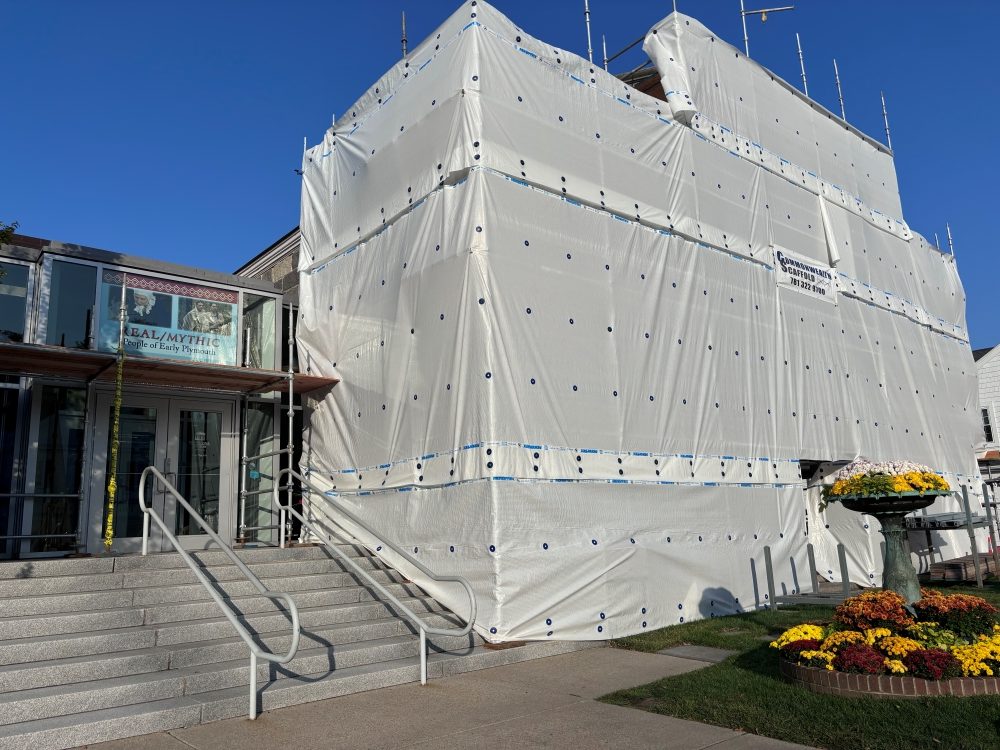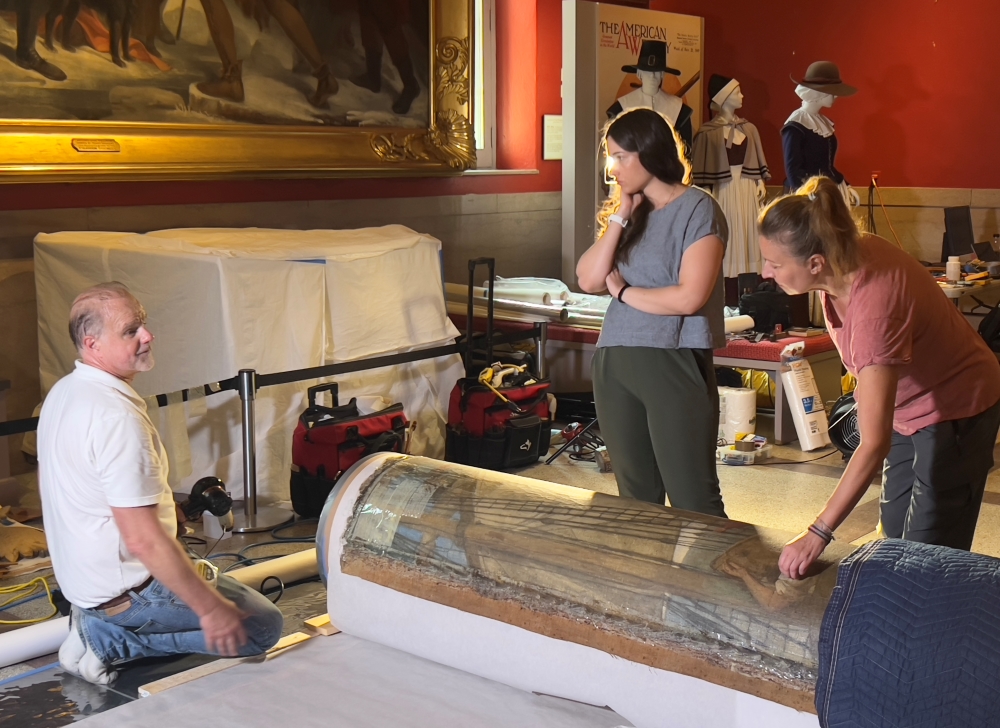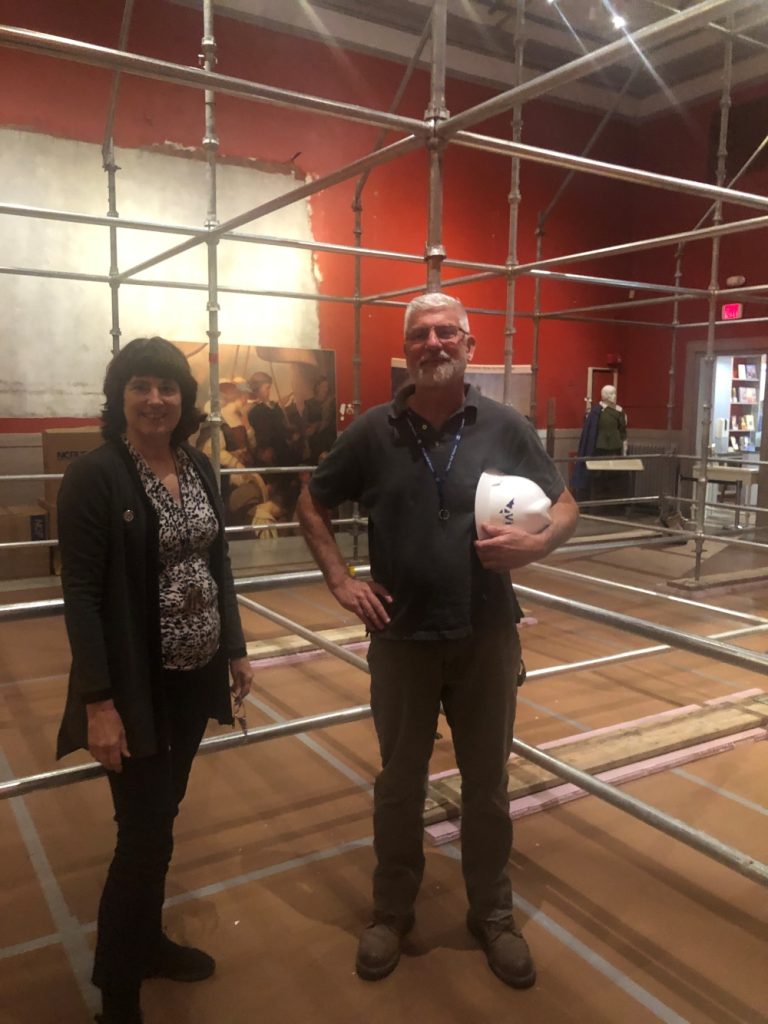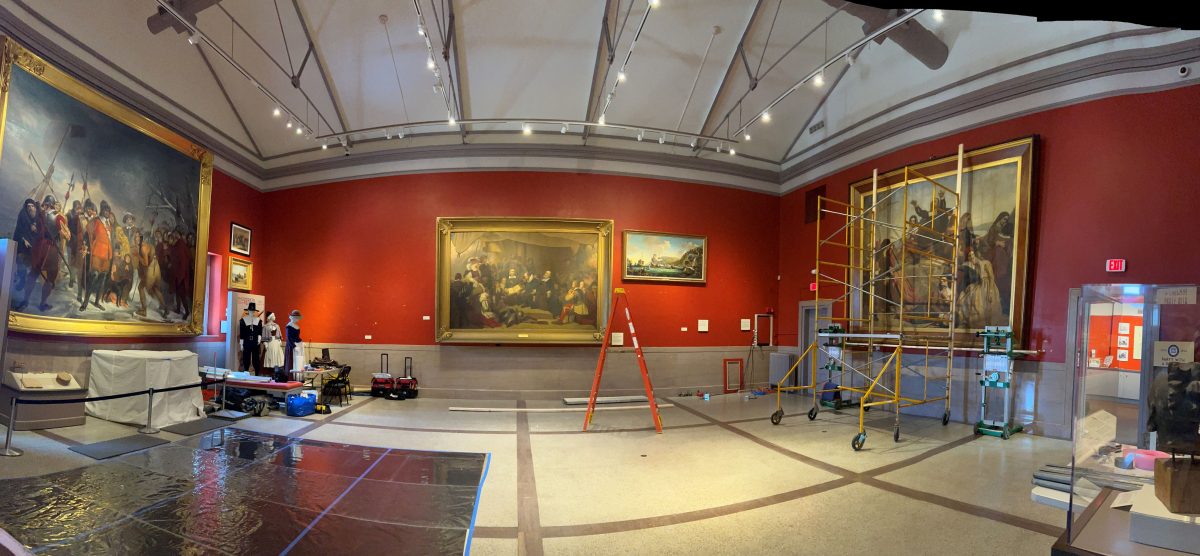Pilgrim Hall, one of the oldest museums in the country, is marking its bicentennial with a $6.2 million renovation project that got underway earlier this month.
The project is focused on restoring two massive historical paintings and replacing the 200-year-old building’s roof.
Because the roof replacement also entails interior work, certain precautions had to be taken to protect precious artifacts inside, said Donna Curtin, Pilgrim’s Hall’s executive director.
“It isn’t an ordinary roofing project,” she said. “Our project here isn’t just the physical outside of the building, but that’s our primary goal. We need to make things watertight.”
Water has been an issue for years. After rain seeped into the main hall on July 9, 2021, a temporary rubber roof was installed. Now it’s finally being replaced.
The project also entails improving the building’s climate control and adding more sophisticated lighting that will help conserve the exhibits while showing them off in more dramatic ways, Curtin said.
The Court Street museum – which will remain open Wednesday through Sunday, from 9:30 a.m. to 5 p.m. – is known for its collection of objects from the Mayflower, as well as founding documents of Plymouth, the first permanent colony of English families in North America. A case in the main hall features the patent that gave permission to the Mayflower pilgrims to establish a colony in Plymouth. It was signed and sealed by the lords of the Council of New England, in England. The document arrived in 1621 on another ship, the Fortune.

Before the work could start, two large historic paintings – Charles Lucy’s “The Departure of the Pilgrims from Delft Haven” (1847) and Edward Parker’s “Embarkation of the Pilgrims” (1875), had to be removed from the hall for safekeeping. Parker’s piece is a copy of a painting by Robert Weir that hangs in the U.S. Capitol Rotunda.
Moving the artworks was complicated, Curtin said. They had to be taken off the wall and detached from their frames. A century-and-a-half of dust had to be cleaned from the back. Then the canvasses, 10-by-14 feet, had to be untacked from their stretchers and carefully laid flat, then rolled. Conservators had to apply beeswax in some places to protect against damage.
The paintings were placed in 20-foot-long tubes and shipped to the conservator in Virginia for restorative work. When the construction work is done, the paintings will be brought back, put up on a scaffold, and hung. Conservators will then continue their work in place. It will be the largest painting conservation project in South Shore history, Curtin said.
“The restoration of the two monumental paintings is a complex months-long process of cleaning over a century of grime and dust from the huge canvases, treating and consolidating areas of loose and flaking paint, re-stretching the canvases onto their frames and restoring the frames,” Curtin said. “There are some particular issues to address as well as it appears that one figure in the Lucy painting of the ‘Departure of the Pilgrims’ may be a later addition not by the artist, and its removal to restore the original scene is being considered.”
Curtin said most of the meticulous conservation work will take place in public view in the main hall next spring after building construction is completed.

On recommendation of the Community Preservation Committee, Town Meeting last year approved $3.2 million for the Pilgrim Hall project. The museum has raised another $800,000 thus far, including $37,500 in state grants, so it still needs another $2.2 million. It is accepting donations on its website for restoration of the two large paintings, which will cost as estimated $600,000, and for the roof project. The museum will receive matching funds up to $100,000 from a group of private donors for all contributions for the painting conservation through year’s end.
Until now, the two paintings hung on opposite walls. But Curtin hopes to place them side by side when they return, clearing one wall for a future work of art by an indigenous artist.
“We fully understand that the place where we have our museum and where we share this history is on the homelands of the Wampanoag people, and their history preceded the history of the colonists that came afterwards,” Curtin said. “We understand that telling that story of Plymouth Colony means that you must be talking about the stories of both of these cultures and their encounters together, how that played out over time.”

Other works besides the two prominent paintings have had to be moved out of the main hall.
All but one of those paintings have already been removed, including William Halsall’s 1882 painting, “The Mayflower on Her Arrival in Plymouth Harbor,” a detail of which is reproduced on the cover of Nathaniel Philbrick’s book, “Mayflower,” and Jenny Brownscombe’s “The First Thanksgiving at Plymouth” (1914).
One painting could not be removed from the room, so carpenters put up a huge structure to protect it and contain it in a climate-controlled space while work continues in the hall, said Curtin. That work, “Landing of the Pilgrims” (1820), was donated by the artist, Henry Sargent, in 1835, and has been on display ever since. It was restored a few years ago, Curtin said.
Also moved from the main hall during the work was a card table embroidered by Mercy Otis Warren when she lived on Queen Street, now North Street.
“That had to be removed from the gallery with great difficulty because the table is wider than the doorways,” said Curtin.
The gallery for temporary exhibits and the original collections gallery will remain open to the public while work in the main hall continues, Curtin said. She expects work in the main hall to be completed by next summer.
Fred Thys can be reached at fred@plymouthindependent.org.

